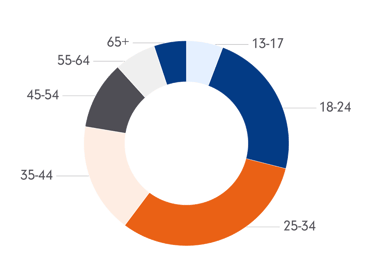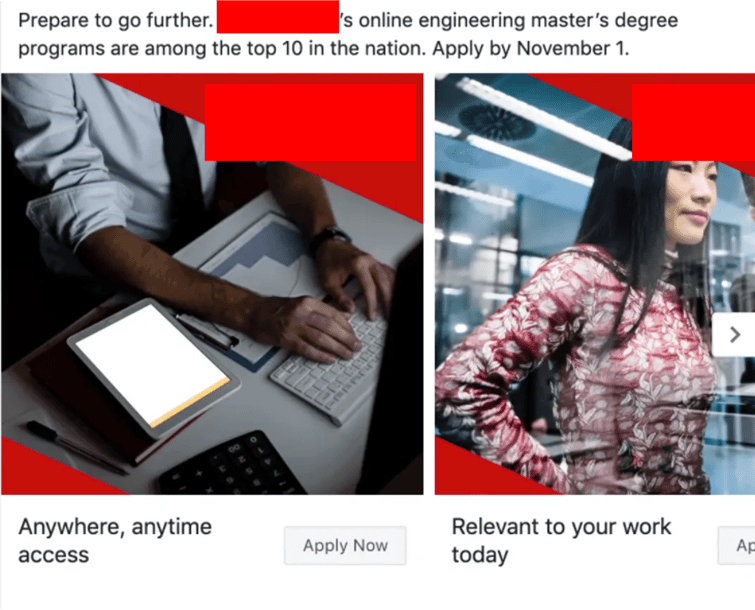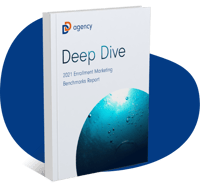Facebook Ads Still Work for Higher Education

February 28, 2023

Here’s something you’ve probably heard before: “Our prospective students aren’t on Facebook anymore; it’s only for older generations now.”
 |
The two biggest age demographics on Facebook?25-34 (32%) and 18-24 (24%).Myth: Busted. |
Now that we’ve gotten that out of the way, let’s dive into how you can captivate your graduate student audience by showing your value as a potential graduate program. As I’m sure you’re well aware, social media users are becoming more reluctant to enter their email address on any old site, so in order to get this golden nugget you’ll need to provide them with something of value.
Newsflash: starting an application is not a “something of value” offer.
 This is a prime example of what I see for higher education ads on Facebook and it’s garbage (you’re welcome, censored university, for not outing you). This does NOT make me want to start my application and it actually deters me from even wanting to learn more about the university. Don’t be like [censored university name here].
This is a prime example of what I see for higher education ads on Facebook and it’s garbage (you’re welcome, censored university, for not outing you). This does NOT make me want to start my application and it actually deters me from even wanting to learn more about the university. Don’t be like [censored university name here].
Attracting Prospective Students with Value
Before you even begin thinking about your target audience, ad spend, or follow-up communications, begin by listing what you have to offer that is valuable for the prospective student.
Assets higher ed websites may have that would be considered valuable: eBooks, blog posts, infographics, webinars, videos, phone calls, virtual campus visits, and/or online quizzes.
What makes these assets valuable? They provide information. They are low barrier-to-entry offers that should give prospective students real insight into your university or program in a way that is most conducive to their media intake preferences.
Not everyone likes the same things – while video is all the rage, some social media users still prefer short-form written content or a visually appealing infographic – so don’t limit your offer to one media type.
What Does This Look Like in Action?
I’m so glad you asked. One university that is doing value-based digital advertising really well is West Virginia University’s Office of Graduate Admissions. They have worked hard to create a whole resource library that houses all of the eBooks and core content pieces that they have put together.
What this content allows them to do is attract prospective graduate students who may not even be set on a program or university. For example, they created A Guide to Financing Graduate School that isn’t just about them, but references all of the major steps and options available to someone pursuing a graduate degree.
Here’s an example of one of their Facebook ads:
 As you can see from the ad copy and resource, this is meant to alleviate some of the pain points that come about when discerning whether grad school is a good fit. And if you download the resource, you’ll see how easy it is to find information without being overwhelmed by “Apply Now” buttons and sales-y language.
As you can see from the ad copy and resource, this is meant to alleviate some of the pain points that come about when discerning whether grad school is a good fit. And if you download the resource, you’ll see how easy it is to find information without being overwhelmed by “Apply Now” buttons and sales-y language.
Impact on Graduate Recruitment Efforts
As a graduate student recruiter you’re probably thinking this all sounds great, but how do I know it’s worth my time/energy? I understand you’re wearing a million hats and I would never want to waste a second of your time, so let’s jump into the actual ROI of these efforts!
West Virginia University’s Office of Graduate Admissions was able to achieve a $0.50 cost-per-session and a cost-per-acquisition (CPA) of $22.77. Sessions were defined as the number of prospects who landed on their website from an ad and CPA defined as new names and email addresses that entered their system.
Content Creates Value, Value Creates Students
Now more than ever you need helpful resources that allow graduate prospects to consume information on their own terms and then come to you with specific questions. Trying to force your way in just isn’t going to work.
Once that content is created, your digital advertising baselines will immediately change for the better as you’ll be able to attract students earlier in their grad school journey (which also translates to cost savings down the road).
If you’re unsure where to start, what content best fits your university or program, or how to analyze your digital advertising benchmarks, book some time with me!
Have the content? Jump into our next post: How to Develop a Social Media Marketing Strategy for Enrollment Marketers!
Find Out the Freshest Industry Benchmarks
Do you know how prospective students are engaging with email? How are virtual events affecting recruitment? Are you considering all three prospective student stages when creating content? Look no further! See how your institution stacks up against other schools across these primary marketing tactics.
Download our free guide, DD’s Deep Dive: Enrollment Marketing Benchmarks Report to learn:
- Benchmark data for four primary marketing tactics: event marketing, email marketing, digital advertising, and content marketing
- New behaviors of prospective grad students as they research and journey through the applicant funnel from initial interest to application completion
- Specific insights on which tactics are the most effective in engaging and converting prospects at all stages
.jpg) EBOOK
EBOOK
See how schools are using HubSpot for their enrollment marketing
Service Categories: Digital Advertising, Social Media Marketing








.png)